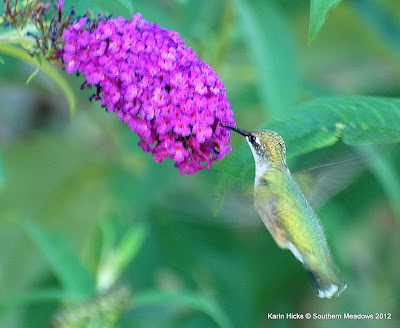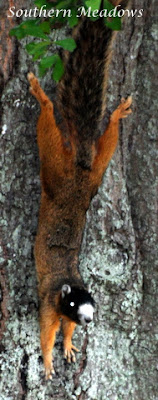W4W: Harmony
When I garden my aspiration is to find harmony with nature. Plants and structures are chosen with a specific purpose in mind. They provide food, water, shelter, or a place to raise young. This applies to the birds, pollinators, insects and gardener alike.
 |
| Chipmunk, Squirrel and Mourning Dove living in harmony |
The purpose of Mother Nature's design is survival. Each species has their own unique characteristic(s) that helps facilitate its survival. Color is one such characteristic that plays an important role in the survival of plants and animals.
 |
| Zinnia |
Plants and pollinators have evolved together and have a symbiotic relationship. The color of a flower exists not for our pleasure but for the benefit of the pollinators who aid in the fruit production and hence the continued survival of the plant and subsequently the survival of the pollinators. They work in harmony.
 |
| Bee and St. Johns Wort |
Most insects don't see longer wave lengths of light (red) at all or as well as they, see shorter wavelengths of light (blue, violet, UV).
Bees for example are attracted to colors on the blue end of the spectrum (violets, blues, yellows and whites). Blooms that look yellow to us appear blue to bees and bees are particularly attracted to the color blue.
On the other hand, bees can't see the color red. To them it appears as a black void. That is not to say that you won't see insects pollinating flowers that they can't see. Other characteristics such as the shape of the blooms or smell can also attract pollinators to the blooms.
 |
| Bee on Beebalm |
Butterflies are particularly attracted to red, yellow, orange, pink and purple.
 |
| Painted Lady on Yarrow |
 |
| Pipevine Swallowtail on Lantana |
But, color attraction can vary by species. The Zebra Swallowtail for example is especially attracted to white blooms.
 |
| Zebra Swallowtail on Heuchera |
Unlike insects, birds are highly attracted to the color red. You will often see hummingbirds pollinating flowers that are red, orange, pink or purple.
Moths, bats and other nighttime pollinators are attracted to blooms that reflect ultraviolet light (whites & yellows). Night blooming flowers such as tomato blooms, phlox, moonflower evening primrose and buddleia work well in attracting these pollinators. The Hummingbird Clearwing Moth is a diurnal pollinator of this group.
Birds see the same color spectrum we do and their coloring is used for a specific purpose. The males are usually the more colorful of the species because their primary purpose is to attract a mate. The females on the other hand are more subdued because they are trying to blend in with their surroundings to protect their eggs and later their young.
Some species use their coloring to blend with their surroundings thus protecting themselves from predators. This anole can blend in nicely with the hosta leaves but can change its coloring to blend in with the plant hook too.
Color is important to the plant and animal world and nature has found a way for them to work harmoniously together. With this post, I am joining Garden Walk Garden Talk for Word for Wednesday: Harmony with Color. Be sure to visit Donna's blog to see more interpretations.











.png)
